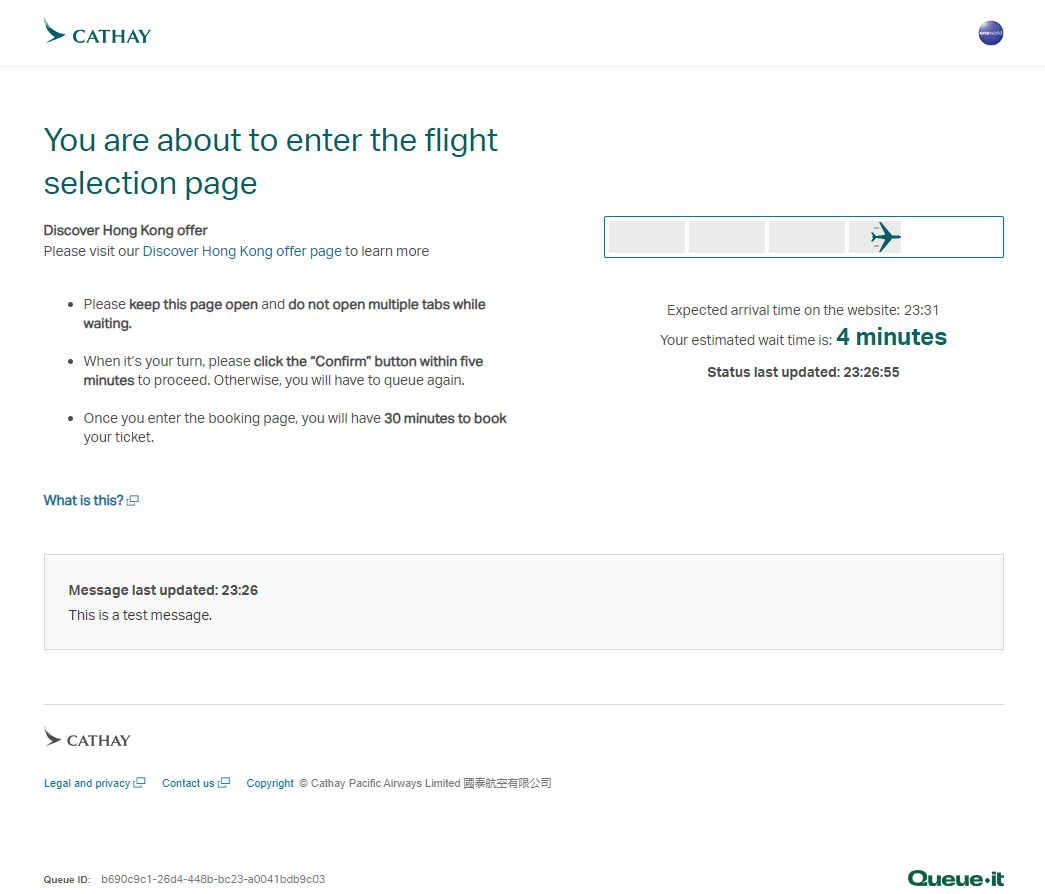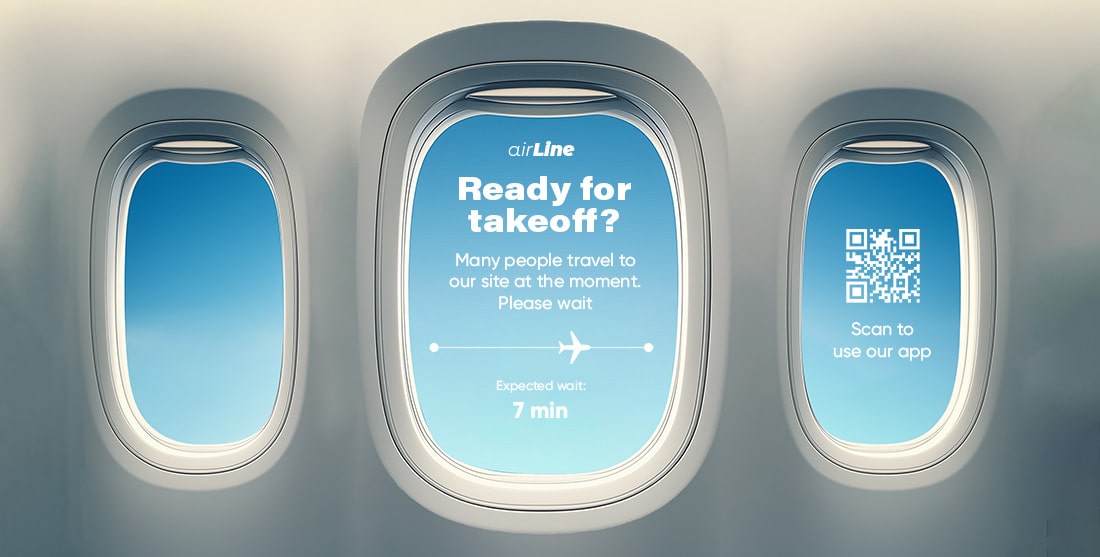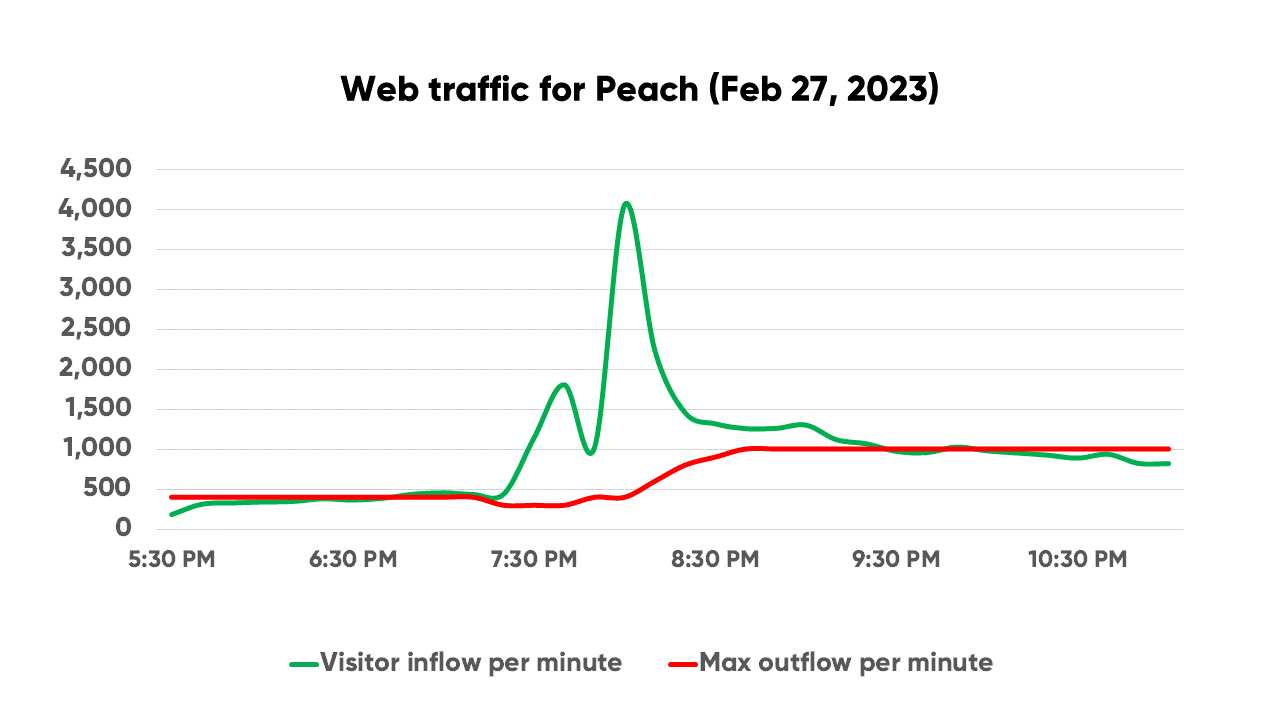Seasonal sales, surprise discounts, and members’ sales are a proven strategy for nurturing loyalty and driving airline ticket sales. But the massive surges in traffic these events attract can be a blessing and a curse. Discover why major airlines are running their promotional events with a virtual waiting room, and how you can use one to prevent airline website crashes and capitalize on your big brand moments.
Airline ticket sales are tough to get right. The complexity and scale of booking systems, along with the huge amounts of data and tight integration with third parties, make airline ticket sales one of the most challenging ecommerce verticals.
And these technical challenges only grow on airlines’ biggest days—when you’re running seasonal sales, surprise discounts, or members’ sales.
As soon as promotions or special fares go live, thousands of travelers flock to your website or app to snap up limited-availability flights. These spikes in site traffic often cause airline websites to produce errors, slow down, or crash altogether.
Discover why major airlines like All Nippon Airways (ANA), Cathay Pacific, and Peach Aviation use Queue-it’s virtual waiting room to ensure a smooth experience, prevent technical issues, and ensure sales success on their biggest days. Learn why it’s so hard to keep airline sites and apps operational during peak demand, and how a traffic control solution can help.
Airlines use a virtual waiting room (AKA an online queue) during high-demand sales events to protect their websites from surging traffic, block bot traffic, and ensure every traveler gets a smooth and fair booking experience.
Many airlines have learned the hard way that web traffic during major sales or booking windows can be unpredictable and intense. Sudden traffic spikes can overwhelm servers, databases, and bottlenecks like payment gateways, causing airline websites to crash when they’re at their most visible.

Qantas, Singapore Airlines, JetBlue, Southwest Airlines, Air India—sudden surges in traffic during flash sales or major announcements have caused all these airlines’ websites to produce errors, slow down, and crash. These site problems:
- Harm sales: Customers can’t buy tickets on a website that doesn’t work. Impatient travelers may look to competitor airlines or third-party booking sites for alternatives, costing airlines both immediate and future business.
- Drain resources: IT teams work frantically to restore the site, while customer service and marketing teams work on crisis management.
- Tarnish reputation: Customers turn to social media to complain and journalists quickly write hit pieces about your botched sale.
- Lost loyalty and trust: A poor experience during a high-demand event can damage customer relationships, resulting in lost loyalty and trust.
The aviation industry uses air traffic control to ensure the safe and orderly flow of aircraft through airspaces and into and out of airports. In the same way, many airlines use website traffic control (or virtual waiting rooms) to ensure the safe and orderly flow of visitors to their websites or mobile apps.

Cathay Pacific's Queue-it waiting room during a sale on flights to Hong Kong
Virtual waiting rooms give you complete control over the flow of traffic to your site, enabling you to:
- Ensure website performance: The virtual waiting room absorbs spikes in traffic and lets you control the flow of customers into your site, ensuring you never exceed the technical capacity of your systems and can sell as fast as possible without crashing or overselling. You can configure Queue-it just to protect key bottlenecks like database calls or payment gateways.
- Improve customer experience: Instead of facing a frustrating crash or site slowdown, customers get redirected to a virtual waiting room where they see their place in line and an estimated wait time. These branded waiting rooms can even feature travel-related content, videos, or promotions to engage users while they wait.
- Deliver fair access: With limited seat availability and time-sensitive promotions, fairness is key. Virtual waiting rooms have sophisticated fairness mechanisms like first-come-first-served access or live raffle randomization, ensuring all customers have an equal chance at getting tickets. This helps avoid accusations of unfair practices and keeps customer satisfaction high.
- Block bots & bad actors: A virtual waiting room keeps bots off your site like a security checkpoint at an airport keeps bad actors off flights. It sits between a webpage on your site and the purchase path. As visitors flow through it in a controlled, orderly manner, you can run identification checks with Queue-it’s suite of bot mitigation tools to determine whether you’ll let them pass through.
RELATED: The Comprehensive Guide to Virtual Waiting Rooms: All Your Questions Answered
“I highly recommend Queue-it for companies that experience traffic surges. It lets us prevent traffic peaks from overloading our systems without compromising the customer experience. The Queue-it team provided dedicated support and we were genuinely grateful to work with them. Queue-it makes both service providers and their customers happy."
Kensuke Morita, Digital Channel Team Manager, All Nippon Airways

Virtual waiting rooms work by redirecting excess traffic to a branded waiting room when customers hit a specific step in the user journey, like visiting a sale page or proceeding to checkout.
Customers are seamlessly flowed from the site to a branded waiting room like the one below, where they see their number in line, their estimated wait time, and a progress bar. From here, they're flowed back to your site at the rate it can handle in a fair, controlled order.

While brands often customize their waiting rooms both in style and in URL to look like the original site, the visitors in them are hosted on the virtual waiting room provider’s servers. This means no strain is placed on the target website’s servers while visitors wait for access.

You can use a virtual waiting room to control traffic in three distinct ways, depending on your use case and needs:
- 24/7 protection: To control unexpected traffic peaks, the solution monitors traffic 24/7 and only activates when visitors exceed a set threshold. The waiting room kicks in automatically and flows visitors to the site at a controlled rate in first-in, first-out order.
- Scheduled events: For planned events or limited-inventory sales, you can set up the waiting room to actively collect all incoming traffic to your website or a specific sale page. All early visitors get gathered on a page with a timer counting down to the sale start. When the timer hits zero, they’re randomized to ensure fairness, then flowed to the site in their randomly assigned order. Late visitors get access in first-in, first-out order.
- Exclusive events: For exclusive members’ sales or frequent flyer events, you can use the waiting room to ensure only the visitors you choose get access. The invite-only waiting room enables you to reward members with truly exclusive access by sending unique single-use links or using two-factor authentication to verify all incoming visitors to your website or a sales page
No matter the scenario, you can use virtual waiting rooms to handle peak periods with confidence, ensuring you don’t lose out on sales and that every customer gets a fair, reliable, and smooth experience.
RELATED: How Queue-it works & Virtual Waiting Room FAQs
Peach Aviation is Japan’s oldest low-cost carrier, operating 25 domestic routes and 12 international routes, serving over 50 million passengers every year.
When COVID travel restrictions eased, Peach ran sales campaigns to encourage passengers to take to the skies once more. These sales were a huge success, but the large traffic they attracted caused major website issues. “It wasn’t a good experience,” says Atsumi Murakami, Peach’s Chief of Innovation. “We received many complaints on social media.”
As a brand committed to customer experience, the Peach team immediately committed to doing better for their next big event—their 11th anniversary sale.
That’s when Murakami and the team discovered Queue-it, a solution he says, “mastered the art of delivering a seamless user experience.” With secure and fast integration via the Akamai EdgeWorkers Connector, an experienced Japanese team, and round-the-clock technical support, “Queue-it was the match we were looking for,” Murakami says.
When Peach’s 11th anniversary event went live, their traffic spiked immediately. It peaked at over 4,000 new visitors per minute (shown by the green line in the chart below). But the waiting room controlled this spike, ensuring a maximum of 1,000 new visitors got access to the sale per minute (red line in chart below).

Across the week-long sale, the waiting room processed over 2 million customers.
Despite the enormous traffic, Murakami says, the sale was a resounding success. Peach sold thousands of tickets, customers got great deals, and the site ran smoothly and reliably through massive demand. “If it was not for the waiting room, we wouldn’t have been able to deliver the same result.”
Peach Aviation's animated Queue-it waiting room
“Before Queue-it, traffic peaks caused a lot of stress for us. We worried the server would crash, and even if it didn’t, we knew it would impact our ability to deliver a good user experience. But with the virtual waiting room in place, we feel protected ... There’s a huge change in our state of mind.”
Atsumi Murakami, Chief OF Innovation

Customers who participated in Peach’s anniversary sale were quick to praise the new user experience. “Though it was a completely new solution we tried, we got a lot of positive feedback on the waiting room on social media and in surveys,” Murakami says.
Some examples of this feedback include (translated from Japanese Tweets):
- “It’s so nice and smooth when you know the waiting time. Bravo Peach!”
- “Peach’s waiting solution feels right, considering how hard it is to get stuck in the middle and kicked out of the sale.”
- “After having suffered at Peach’s sales for my whole university life … I’m just beyond words.”

Tweet from Peach customer (translated from Japanese): “After having suffered at Peach’s sales for my whole university life … I’m just beyond words.”
They do. But at scale, every system breaks.
There is no “too big to fail” in the world of websites. Amazon, Walmart, Apple, the IRS—surging web traffic has taken all of them offline.
If you’re preparing for a large traffic spike, you’ll want to optimize your website in many ways, including scaling your systems.
But scaling alone is expensive at best, and risky at worst. It can be:
- Expensive: Most websites are built to perform under their usual amount of traffic. Building a website that can handle huge traffic peaks that only come a few times a year is like buying a house with 10 extra bedrooms and bathrooms because your family comes to visit sometimes—it’s expensive, impractical, and unnecessary.
- Reactive: Because traffic levels are hard to predict and autoscaling takes time to kick in, your systems likely won’t be ready in the critical moment they’re needed.
- Risky: Even if autoscaling or pre-scaling could handle these surges, bottlenecks almost always emerge. This means traffic still overloads areas that are difficult or impossible to scale, such as databases, inventory management systems, third-party features like payment gateways, and performance-intensive features like dynamic search or a “recommended for you” panel.
“Our systems struggled with traffic spikes. We first tried to handle these issues with autoscaling, but it rarely reacted fast enough to keep up with the sudden surge in users.”
Atsumi Murakami, Chief of Innovation

A virtual waiting room complements your autoscaling approach and gives you confidence your site will perform by controlling what other crash-prevention tactics can't: the flow of traffic to the site.
In a recent survey, Queue-it customers said the virtual waiting room gives them control over their scaling costs, their customer experience, and their operational efficiency:
- 84% say their customers’ online experience has improved
- 85% say they sell through product more efficiently
- Customers reduced on-call staff needed during sales by an average of 48%
- Customers reported an average 37% decrease in server scaling costs and 33% decrease in database scaling costs
RELATED: Queue-it Customer Survey: Real Virtual Waiting Room Results From Real Customers
Preparedness is key to making the most of your brand’s biggest days. Whether it’s a flash sale, a members sale, or just a large seasonal event, a virtual waiting room solution like Queue-it ensures you’re not only ready for the surge, but also positioned to capitalize on it. You get the confidence of knowing you can control traffic and keep your site online without compromising the customer experience.
Queue-it is the market leading virtual waiting room solution, having served over 75 billion users across 172 countries. With a mission to deliver online fairness to all, Queue-it empowers the world’s biggest businesses to perform on their busiest days. When Cathay Pacific, All Nippon Airways, and Peach Aviation need to manage high-demand events, they turn to Queue-it. Book a demo today and start preparing for your next high-profile sale or event.